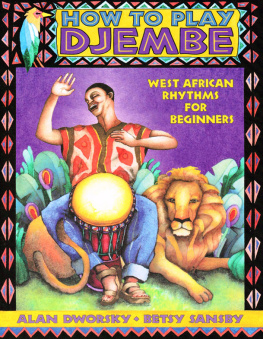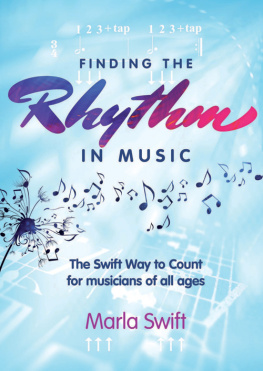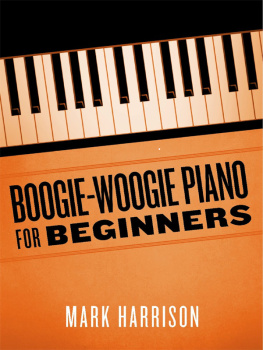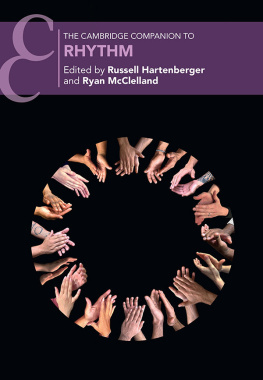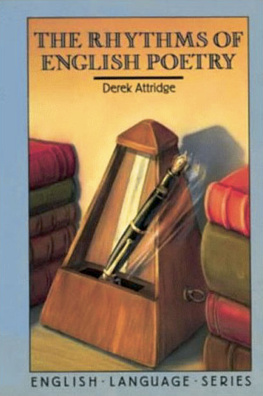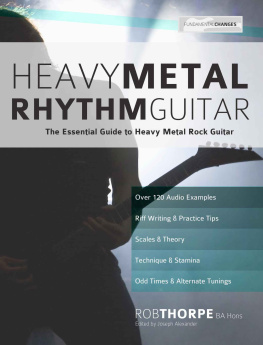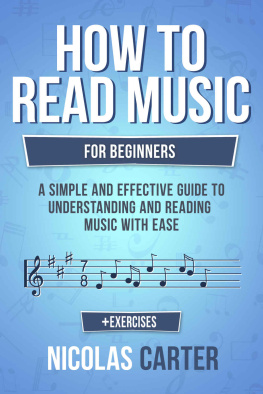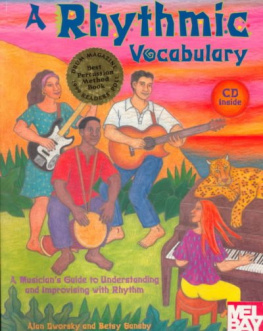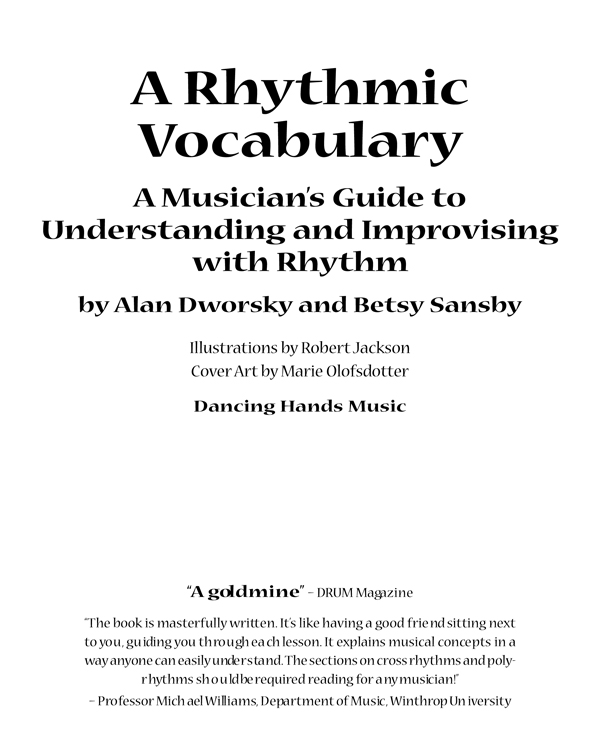
A Rhythmic Vocabulary: A Musicians Guide to Understanding and Improvising with Rhythm
Copyright 1997, 1999, by Alan Dworsky and Betsy Sansby
All rights reserved. No part of this book may be used or reproduced by any means without permission except the blank charts on pages 201 and 202.
Published by
Dancing Hands Music
4275 Churchill Circle
Minnetonka, MN, 55345
phone or fax: 612-933-0781
www.dancinghands.com
Book design by MacLean and Tuminelly
Cover production by Kelly Doudna
Interior design and production by Chris Long, who was tireless in his devotion to this project
Illustrations on pages 14 and 15 by Jay Kendell
Printed in the United States of America with soy ink on recycled, acid-free paper by Banta ISG (Viking Press)
Library of Congress Catalog Card Number: 97-091788
ISBN 0-9638801-2-8
For Jerry Sansby the first drummer in the family
W e would like to express our gratitude to all our teachers, especially Marc Anderson, who generously shared his knowledge of Ghanaian rhythms with love and reverence for the culture that created them. Wed also like to thank those who have taught us through their books and videos, especially David Locke (for his clear presentation and analysis of Ghanaian rhythms), Phil Maturano (for his organization of patterns and his concept of relayed time shifting, which we adapted into our lesson on bending a pattern), Reinhard Flatischler (whose Ta Ke Ti Na method we adapted into rhythm walking), and Gordy Knudtson (from whom we learned both in his books and in private lessons a wide variety of cross-rhythms and other patterns, as well as the method we call say-it-and-play-it). We are also indebted to the creators of all the other sources listed at the back of this book and to all the unknown creators of the rhythms of the world.
Finally, we would like to thank Mamady Keita, who has taught us through his recordings, and whose brilliant djembe playing has been an unending source of inspiration and delight.
VARIATION TECHNIQUES
GETTING STARTED
PATTERNS, CONCEPTS, AND TECHNIQUES
FOR FURTHER STUDY AND ENJOYMENT
RHYTHMIC CONCEPTS

T his book is a roadmap to rhythm for any musician. Its for guitar players intrigued by the rhythms of world music. Its for keyboard players whove studied scales and chords and now want to study rhythm in a systematic way. Its for drummers, bass players, and sax players who want to groove and solo with a deeper understanding of rhythmic structure. Whatever your instrument, if you want to play funkier and dont mind using your head to do it, this book is for you.
The patterns in this book come from African and Afro-Cuban rhythms, the source for the groove in most contemporary music. But our purpose here is not to teach any specific style of drumming. Our purpose is to illuminate the subject of rhythm in general so youll be able to navigate comfortably in any rhythmic territory.
To do that, weve organized representative patterns according to their structure, arranged them roughly in order of difficulty, and presented them in bite-sized lessons. While we present the patterns, we also present rhythmic concepts and techniques you can use to create patterns of your own. And we include plenty of examples of how patterns can be varied and combined when you improvise or solo.
Weve tried to make this book as user-friendly as possible. For example, we use big, easy-to-read charts that are so simple even non-musicians can understand them. Any time we introduce a new concept or technique, we highlight it in the margin for easy reference. Any time we introduce a new term, we put it in bold letters, define it on the spot, and add it to the glossary at the back of the book. Weve also included some blank charts you can photocopy and use to write down patterns of your own. Weve even used a special binding that makes the book stay open without the help of a shoe.
The CD that comes with this book helps create a realistic, three-dimensional rhythmic context for you to play in right from the start. It contains two reference rhythms youll be playing with while you practice. Each of those rhythms is recorded for about five minutes at each of seven different speeds so you can practice at your own level. And as soon as you feel like putting your instrument aside and using your whole body to learn the patterns, check out the chapter on rhythm walking.
From time to time, we tell you that a pattern comes from a particular African or Afro-Cuban rhythm. We do this to acknowledge our sources where we know the name of a rhythm and as a reminder that the patterns in this book arent just mathematical abstractions. But just because we say a pattern can be found in a particular rhythm, it doesnt mean the pattern can be found only there. Most of the patterns in this book are found in many rhythmic traditions around the world and many can be heard in rock, funk, jazz, and other contemporary styles.
We hope this book will help you express yourself better in the language of rhythm and inspire you to delve deeper into the world of African and Afro-Cuban rhythms. At the back of the book, weve included a list of sources for further study and a list of CDs of great drumming from around the world. But dont stop there. Look for opportunities to experience the real thing by going to concerts, taking lessons, or joining an ensemble. Theres no substitute for the direct experience of these magnificent rhythms.

I n this chapter, while we explain how to read the charts well also be explaining the basic concepts you need to know to start working your way through this book. If any of the concepts seem confusing at first, dont worry. Theyll all become clearer as you begin using them in the coming lessons.
Because were mainly interested in teaching the fundamentals of rhythmic structure, were going to focus on just two variables of rhythm: 1) when sounds occur, and 2) what the sounds are. To notate these two variables, we use box charts instead of standard music notation because for our purposes theyre simpler and clearer.
Heres what an empty chart looks like:

Pulses and subdivisions
The main function of the top row on a chart is to show how were counting. But we also use the count row to show the pulse, which is indicated by shaded boxes (1 and 3 on the chart above). By the pulse, we mean the underlying metronomic rhythm people feel in their bodies when music is played. Like your own pulse, its made up of a series of regularly-spaced kinesthetic events called individual pulses. But unlike your own pulse, the pulse of a rhythm is a culturally-influenced, subjective phenomenon.
In African and Afro-Cuban music, the pulse is sometimes played on a drum or other percussion instrument. But often the pulse is silent, and like a heartbeat holds everything together without ever being heard. Because the pulse is so fundamental to rhythm, we present all the patterns in this book in relation to a pulse and have you tap the pulse in your feet while you play the patterns.
The time span between pulses can be divided into smaller units called
Next page

